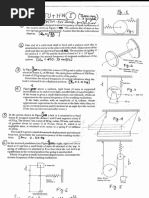Approximate Methods of Distribution System Analysis (2) : 3 Lecture's Outline
Uploaded by
JaleesApproximate Methods of Distribution System Analysis (2) : 3 Lecture's Outline
Uploaded by
Jalees8/18/2016
Lecture 3rd
Approximate Methods of
Distribution System Analysis (2)
Course Teacher:
Dr. Muhammad Mohsin Aman
Course Code:
EE-524
Course Title:
Electrical Power Distribution System Engineering -1
Venue:
Department of Electrical Engineering , NED University Karachi.
1
3rd Lecture’s Outline
Dr. Muhammad Mohsin Aman 1
8/18/2016
3rd Lecture’s Outline
� Distribution System Load Models
�Uniformly Distributed Loads
�Lumped Load models
� Load Models
� Uniformly Distributed Load Model
� Lumped Load Model
� Lumping Loads in Geometric Configurations
� Rectangular Configuration
� Triangular Configuration
3
Distribution of Loads
Dr. Muhammad Mohsin Aman 2
8/18/2016
Distribution of Loads
Two load models can be assumed for voltage drop calculations:
• Uniformly Distributed Loads
• Lumped Load models
Uniformly Distributed Loads
• Many times it can be assumed that loads are uniformly distributed along a line
where the line can be a three-phase, two-phase, or single-phase feeder or lateral.
This is certainly the case on single-phase laterals where the same rating
transformers are spaced uniformly over the length of the lateral.
• When the loads are uniformly distributed, it is not necessary to model each load
in order to determine the total voltage drop from the source end to the last load.
• Figure 3.6 shows a generalized line with n uniformly distributed loads.
Dr. Muhammad Mohsin Aman 3
8/18/2016
Uniformly Distributed Loads
Voltage Drop
• Figure 3.6 shows n uniformly spaced loads dx miles apart. The loads are all equal
and will be treated as constant current loads with a value of di. The total current
into the feeder is IT.
• It is desired to determine the total voltage drop from the source node (S) to the
last node n.
Uniformly Distributed Loads
Voltage Drop (cont..)
Let
Dr. Muhammad Mohsin Aman 4
8/18/2016
Uniformly Distributed Loads
Voltage Drop (cont..)
Let
Uniformly Distributed Loads
Voltage Drop (cont..)
Let
10
Dr. Muhammad Mohsin Aman 5
8/18/2016
Uniformly Distributed Loads
Voltage Drop (cont..)
Let
11
Uniformly Distributed Loads
Voltage Drop (cont..)
Let
12
Dr. Muhammad Mohsin Aman 6
8/18/2016
Uniformly Distributed Loads
Voltage Drop (cont..)
Equation 3.16 gives the general equation for computing the total voltage drop from the
source to the last node n for a line of length l. In the limiting case where n goes to
infinity, the final equation becomes:
In Equation 3.17, Z represents the total impedance from the source to the end of the
line. The voltage drop is the total from the source to the end of the line.
13
Uniformly Distributed Loads
Voltage Drop (cont..)
• The equation 3.17 can be interpreted in two ways.
1. The first is to recognize that the total line distributed load can be lumped at the
midpoint of the lateral as shown in Figure 3.7.
14
Dr. Muhammad Mohsin Aman 7
8/18/2016
Uniformly Distributed Loads
Voltage Drop (cont..)
2. A second interpretation of Equation 3.17 is to lump one-half of the total line load
(current) at the end of the line (node n). This model is shown in Figure 3.8.
Figures 3.7 and 3.8 give two different models that can be used to calculate the
total voltage drop from the source to the end of a line with uniformly distributed
loads.
15
Uniformly Distributed Loads
Power Loss
Of equal importance in the analysis of a distribution feeder is the power loss. If the
model of Figure 3.7 is used to compute the total three-phase power loss down the line,
the result is
When the model of Figure 3.8 is used to compute the total three-phase power loss, the
result is
It is obvious that the two models give different results for power loss. The question is,
which one is correct? The answer is neither one.
16
Dr. Muhammad Mohsin Aman 8
8/18/2016
Uniformly Distributed Loads
Power Loss (cont…)
• To derive the correct model for power loss, reference is made to Figure 3.6 and
the definitions for the parameters in that figure. The total three-phase power loss
down the line will be the sum of the power losses in each short segment of the
line.
• For example, the three-phase power loss in the first segment is
17
Uniformly Distributed Loads
Power Loss (cont…)
18
Dr. Muhammad Mohsin Aman 9
8/18/2016
Uniformly Distributed Loads
Power Loss (cont…)
Where R = r ⋅ l, the total resistance per phase of the line segment, Equation 3.25 gives
the total three-phase power loss for a discrete number of nodes and line segments.
19
Uniformly Distributed Loads
Power Loss (cont…)
For a truly uniformly distributed load, the number of nodes goes to infinity. When that
limiting case is taken in Equation 3.25, the final equation for computing the total three-
phase power loss down the line is given by:
20
Dr. Muhammad Mohsin Aman 10
8/18/2016
Uniformly Distributed Loads
Power Loss (cont…)
A circuit model for Equation 3.26 is given in Figure 3.9. From a comparison of
Figures 3.7 and 3.8, used for voltage drop calculations, to Figure 3.9, used for power
loss calculations, it is obvious that the same model cannot be used for both voltage
drop and power loss calculations.
21
The Exact Lumped Load Model
22
Dr. Muhammad Mohsin Aman 11
8/18/2016
Distribution of Loads
In the previous lecture, we have seen two load models can be assumed for
voltage drop calculations:
• Uniformly Distributed Loads
• Lumped Load models
23
Voltage Drop Model for Uniformly Distributed Loads
For voltage drop mode, the total voltage drop from the source to the last node n for a
line of length is given by:
�1 �
Vdrop total � Re � � Z � I T �
�2 �
In Equation, Z represents the total impedance from the source to the end of the line.
The voltage drop is the total from the source to the end of the line.
24
Dr. Muhammad Mohsin Aman 12
8/18/2016
Voltage Drop Model for Uniformly Distributed Loads
• The equation 3.17 can be
interpreted in two ways.
1. The first is to recognize that the
total line distributed load can be
lumped at the midpoint of the lateral
as shown in Figure.
2. A second interpretation of
Equation 3.17 is to lump one-half of
the total line load (current) at the end
of the line (node n). This model is
shown in Figure 3.8.
25
Power Loss Model for Uniformly Distributed Loads
• For a truly uniformly distributed load, the number of nodes goes to infinity. When
that limiting case is taken in Equation 3.25, the final equation for computing the total
three-phase power loss down the line is given by:
• A circuit model for Equation 3.26 is given in Figure 3.9. From a comparison of
Figures 3.7 and 3.8, used for voltage drop calculations, to Figure 3.9, used for power
loss calculations, it is obvious that the same model cannot be used for both voltage
drop and power loss calculations.
26
Dr. Muhammad Mohsin Aman 13
8/18/2016
The Exact Lumped Load Model
�In the previous sections lumped load models were developed.
�It was shown that the same models cannot be used for the computation of
the total power loss down the line.
�What is needed is one model that will work for both voltage drop and
power loss calculations.
�Figure 3.10 shows the general configuration of the exact model that will
give correct results for voltage drop and power loss.
27
The Exact Lumped Load Model
�In Figure 3.10 a portion (Ix) of the total line current (IT) will be modeled kl
miles from the source end, and the remaining current (cIT) will be modeled at
the end of the line. The values of k and c need to be derived.
�In Figure 3.10 the total voltage drop down the line is given by:
28
Dr. Muhammad Mohsin Aman 14
8/18/2016
The Exact Lumped Load Model
�where
• Z = total line impedance in ohms
• k = factor of the total line length where the first part of the load current is
modeled
• c = factor of the total current to place at the end of the line such that
IT = Ix +c⋅IT
29
The Exact Lumped Load Model
�It has shown that the total voltage drop down the line is given by:
�Set Equation 3.17 equal to Equation 3.27:
�Equation 3.29 shows that the terms inside the brackets on both sides of the
equal sign need to be set equal, that is
�Simplify Equation 3.30 by dividing both side of the equation by ZIT:
30
Dr. Muhammad Mohsin Aman 15
8/18/2016
The Exact Lumped Load Model
�Solve Equation 3.31 for k:
�The same procedure can be followed for the power loss model. The total
three-phase power loss in Figure 3.10 is given by:
�The model for the power loss of Figure 3.9 gives the total three-phase
power loss as:
31
The Exact Lumped Load Model
�Equate the terms inside the brackets of Equations 3.33 and 3.34 and
simplify:
�Put the value of k from Eqn. 3.35.
�Solving Equation 3.36 for c results in:
32
Dr. Muhammad Mohsin Aman 16
8/18/2016
The Exact Lumped Load Model
�Substitute Equation 3.37 into Equation 3.32 and solve for k:
�The interpretation of Equations 3.37 and 3.38 is that
� one-third of the load should be placed at the end of the line,
� and two-thirds of the load placed one-fourth of the way from the source
end.
� Figure 3.11 gives the final exact lumped load model.
33
Lumping Loads in Geometric Configurations
34
Dr. Muhammad Mohsin Aman 17
8/18/2016
Lumping Loads in Geometric Configurations
�Many times feeder areas can be represented by geometric configurations
such as rectangles, triangles, and trapezoids.
�By assuming a constant load density in the configurations, approximate
calculations can be made for computing the voltage drop and total power
losses.
�The approximate calculations can aid in the determination of the maximum
load that can be served in a specified area at a given voltage level and
conductor size.
35
Lumping Loads in Geometric Configurations
�For all of the geographical areas to be evaluated, the following definitions
will apply:
� D = load density in kVA/mile2
� PF = assumed lagging power factor
� z = line impedance in Ω/mile
� l = length of the area
� w = width of the area
� kVLL = nominal line-to-linevoltage in kV
� It will also be assumed that the loads are modeled as constant current
loads.
36
Dr. Muhammad Mohsin Aman 18
8/18/2016
Lumping Loads in Geometric Configurations
1. Rectangle
37
Rectangle
�A rectangular area of length l and width w is to be served by a primary
main feeder. The feeder area is assumed to have a constant load density with
three phase laterals uniformly tapped off of the primary main.
�Figure 3.12 is a model for the rectangular area.
38
Dr. Muhammad Mohsin Aman 19
8/18/2016
Rectangle
�Figure 3.12 represents a rectangular area of constant load density being
served by a three-phase main running from node n to node m.
�It is desired to determine the total voltage drop and the total three-phase
power loss down the primary main from node n to node m.
39
Rectangle
�The total current entering the area is given by:
�An incremental segment is located x miles from node n.
�The incremental current serving the load in the incremental segment is
given by:
�The current in the incremental segment is given by:
�The voltage drop in the incremental segment is
40
Dr. Muhammad Mohsin Aman 20
8/18/2016
Rectangle
�The total voltage drop down the primary main feeder is
�Evaluating the integral and simplifying:
where Z = z ⋅ l
�Equation 3.43 gives the same result as that of Equation 3.17, which was
derived for loads uniformly distributed along a feeder.
�The only difference is the manner in which the total current (IT) is
determined.
41
Rectangle
�The bottom line is that the total load of a rectangular area can be modeled at
the centroid of the rectangle as shown in Figure 3.13.
�It must be understood that in Figure 3.13, with the load modeled at the
centroid, the voltage drop computed to the load point will represent the total
voltage drop from node n to node m.
42
Dr. Muhammad Mohsin Aman 21
8/18/2016
Rectangle
�A similar derivation can be done in order to determine the total three phase
power loss down the feeder main. The power loss in the incremental length is
�The total three-phase power loss down the primary main is
�Evaluating the integral and simplifying:
where R = r ⋅ l
43
Rectangle
�Equation 3.44 gives the same result as that of Equation 3.26. The only
difference, again, is the manner in which the total current IT is determined.
�The model for computing the total three-phase power loss of the primary
main feeder is shown in Figure 3.14. Once again, it must be understood that
the power loss computed using the model of Figure 3.14 represents the total
power loss from node n to node m.
44
Dr. Muhammad Mohsin Aman 22
8/18/2016
Problem
Lumping Loads in Rectangle Configurations
45
Problem
�It is proposed to serve a rectangular area of length 10,000 ft. and width of
6000 ft. The load density of the area is 2500 kVA/mile2 with a power factor of
0.9 lagging.
�The primary main feeder uses 336,400 26/7 ACSR on a pole configured as
shown in Figure 3.3. The impedance of the line was computed to be
46
Dr. Muhammad Mohsin Aman 23
8/18/2016
Problem
�The question at hand is what minimum standard nominal voltage level can
be used to serve this area without exceeding a voltage drop of 3% down the
primary main? The choices of nominal voltages are 4.16 kV and 12.47 kV.
Compute, also, the total three-phase power loss.
�The area to be served is shown in Figure 3.15.
47
Solution
�sa
48
Dr. Muhammad Mohsin Aman 24
8/18/2016
Solution
�sa
49
Solution
�It is clear that the nominal voltage of 4.16 kV will not meet the criteria of a
voltage drop less than 3.0%. For a nominal voltage of 12.47 kV, the total area
current is
50
Dr. Muhammad Mohsin Aman 25
8/18/2016
Solution
�The nominal voltage of 12.47 kV is more than adequate to serve this load. It
would be possible at this point to determine how much larger the area could be
and still satisfy the 3.0% voltage drop constraint.
51
Solution
�For the 12.47 kV selection, the total three-phase power loss down the
primary main is
52
Dr. Muhammad Mohsin Aman 26
8/18/2016
Lumping Loads in Geometric Configurations
2. Triangle
53
Triangle
�Figure 3.16 represents a triangular area of constant load density being
served by a three-phase main running from node n to node m.
�It is desired to determine the total voltage drop and the total three-phase
power loss down the primary main from node n to node m.
54
Dr. Muhammad Mohsin Aman 27
8/18/2016
Triangle
�The area of the triangle is
�The total current entering the area is given by:
�The current entering the incremental line segment is
where A1 = area of triangle up to the incremental line segment.
55
Triangle
�asasd
56
Dr. Muhammad Mohsin Aman 28
8/18/2016
Triangle
�asasd
57
Triangle
�Equation 3.53 shows that the total voltage drop from the vertex to the base
of the triangular area can be computed by modeling the total triangle load two-
thirds of the distance between the vertex and the base of the triangle.
�The model for the voltage drop calculation is shown in Figure 3.17.
58
Dr. Muhammad Mohsin Aman 29
8/18/2016
Triangle
�A similar derivation can be made for the power loss model. The power loss
in the incremental line segment is
59
Triangle
�The total three-phase power loss from node n to node m becomes:
�Evaluating the integral and simplifying:
�Equation 3.55 gives the total three-phase power loss down the primary main
from node n to node m.
60
Dr. Muhammad Mohsin Aman 30
8/18/2016
Triangle
�The model for the power loss is given in Figure 3.18.
61
Problem
Lumping Loads in Triangle Configurations
62
Dr. Muhammad Mohsin Aman 31
8/18/2016
Problem
�The triangular area shown in Figure 3.19 is to be served by a feeder of
nominal voltage 12.47 kV. The load density of the area is 3500
kVA/mile2 at a power factor of 0.9 lagging. The conductor on the
primary main is 336,400 26/7 ACSR, and the configuration of the pole is
that of Figure 3.3.
�The impedance of the line is
z=0.306+j0.6272 ohm/mile and the Kdrop
factor is 0.00035291% drop/kVA-mile
�Krise factor for the given conductor
is 0.00040331% rise/kvar-mile.
63
Problem
�Use the Kdrop factor from the line of Example 3.2 and determine the percent
voltage drop from node n to node m.
64
Dr. Muhammad Mohsin Aman 32
8/18/2016
Solution
�sads
65
Solution
�sads
66
Dr. Muhammad Mohsin Aman 33
8/18/2016
Solution
�Suppose now that a shunt capacitor bank is to be installed somewhere
along the primary main in order to limit the percent voltage drop to node
m to 3.0%. Two decisions must be made:
1. Three-phase rating of the capacitor bank
2. Location of the capacitor bank
�The total reactive power of the area was computed to be 2462.6 kvar.
That means that a capacitor bank rated up to 2462.6 can be used without
causing the feeder to go into a leading power factor condition. Since this
is assumed to be the peak load, a capacitor bank rated at 1800 kvar (three-
phase) will be used in order to prevent a leading power factor condition
for a smaller load. Depending upon the load curve during the day, this
bank may or may not have to be switched. 67
Solution
�dsad
68
Dr. Muhammad Mohsin Aman 34
8/18/2016
Solution
�The total three-phase power loss down the primary main before the
shunt capacitor is added is computed by lumping the total triangular load
at:
69
Dr. Muhammad Mohsin Aman 35
���������������������������������������������������������������������������
���������������������������������������������������������������������������������
�����������������������������������������������������
You might also like
- Apprentice Fitter Test: QUESTION 1: Choose The Best Answer From The Given OptionsNo ratings yetApprentice Fitter Test: QUESTION 1: Choose The Best Answer From The Given Options6 pages
- Chapter 5 - Power Delivery System AnalysisNo ratings yetChapter 5 - Power Delivery System Analysis18 pages
- Lecture - 04 Lecture - 04: EEN-206: Power Transmission and Distribution EEN-206: Power Transmission and DistributionNo ratings yetLecture - 04 Lecture - 04: EEN-206: Power Transmission and Distribution EEN-206: Power Transmission and Distribution19 pages
- Lecture 3: Approximate Analysis: ECE 5984: Power Distribution System AnalysisNo ratings yetLecture 3: Approximate Analysis: ECE 5984: Power Distribution System Analysis17 pages
- Flujo de Carga en Circuitos SimplificadosNo ratings yetFlujo de Carga en Circuitos Simplificados9 pages
- ELG3316 - Assignment 2 - Winter 2025 (1)No ratings yetELG3316 - Assignment 2 - Winter 2025 (1)2 pages
- (IJCST-V4I3P33) :arindam Banerjee, Amarnath Sanyal, Dr. Sourish Sanyal, Raju Basak, Subhasree ChatterjeeNo ratings yet(IJCST-V4I3P33) :arindam Banerjee, Amarnath Sanyal, Dr. Sourish Sanyal, Raju Basak, Subhasree Chatterjee6 pages
- Unit-Ii Performance of Transmission LinesNo ratings yetUnit-Ii Performance of Transmission Lines38 pages
- 14 - 1994 - Novel Method For Solving Radial Distribution Networks - DAS100% (1)14 - 1994 - Novel Method For Solving Radial Distribution Networks - DAS8 pages
- A Three Phase Unbalanced Power Flow Method For Secondary Distribution System PDFNo ratings yetA Three Phase Unbalanced Power Flow Method For Secondary Distribution System PDF6 pages
- TD Module II AnalysisofTransmissionLinesNo ratings yetTD Module II AnalysisofTransmissionLines41 pages
- V220 /0 Volts: Show That The Per-Unit Impedance of A Transformer Is Same Whether Calculated From 5No ratings yetV220 /0 Volts: Show That The Per-Unit Impedance of A Transformer Is Same Whether Calculated From 52 pages
- A Linear Three-Phase Load Flow For Power Distribution SystemsNo ratings yetA Linear Three-Phase Load Flow For Power Distribution Systems2 pages
- ) : ∂ ∂z µE (2.29) γ µ, which, for lossless β = ω µ = ω, (2.30)No ratings yet) : ∂ ∂z µE (2.29) γ µ, which, for lossless β = ω µ = ω, (2.30)8 pages
- Power System By: Roel B. Calano: Problem 1No ratings yetPower System By: Roel B. Calano: Problem 110 pages
- EE486_Lect8_Economic Load Dispatch Problem With Consideration of Transmission LossesNo ratings yetEE486_Lect8_Economic Load Dispatch Problem With Consideration of Transmission Losses15 pages
- 5.0 (5.5 - 5.8) Line Model and PerformanceNo ratings yet5.0 (5.5 - 5.8) Line Model and Performance27 pages
- Al-Balqa Applied University: DR - Audih 1No ratings yetAl-Balqa Applied University: DR - Audih 157 pages
- XLine Modeling - Short Transmission LineNo ratings yetXLine Modeling - Short Transmission Line18 pages
- Three-Phase Formulation The Power System AnalysisNo ratings yetThree-Phase Formulation The Power System Analysis5 pages
- ABB - Protection Application Handbook (1999)No ratings yetABB - Protection Application Handbook (1999)356 pages
- Theory of Elastisity, Stability and Dynamics of Structures Common ProblemsFrom EverandTheory of Elastisity, Stability and Dynamics of Structures Common ProblemsNo ratings yet
- Method of Moments for 2D Scattering Problems: Basic Concepts and ApplicationsFrom EverandMethod of Moments for 2D Scattering Problems: Basic Concepts and ApplicationsNo ratings yet
- Load Characteristics and Power Factor Correction: 6 Lecture's OutlineNo ratings yetLoad Characteristics and Power Factor Correction: 6 Lecture's Outline29 pages
- Lecture No. 12 Power System Reliability and Static Reliability Evaluation ModelsNo ratings yetLecture No. 12 Power System Reliability and Static Reliability Evaluation Models28 pages
- Starting With The Name of Allah, The Most Beneficient and The Most MercifulNo ratings yetStarting With The Name of Allah, The Most Beneficient and The Most Merciful38 pages
- DTS (A) /0026: Karachi Electric Supply Corporation LimitedNo ratings yetDTS (A) /0026: Karachi Electric Supply Corporation Limited1 page
- Load Characteristics: 5 Lecture's OutlineNo ratings yetLoad Characteristics: 5 Lecture's Outline36 pages
- Shunt Capacitor Banks: 7 Lecture's OutlineNo ratings yetShunt Capacitor Banks: 7 Lecture's Outline30 pages
- Approximate Methods of Distribution System Analysis: 2 Lecture's OutlineNo ratings yetApproximate Methods of Distribution System Analysis: 2 Lecture's Outline22 pages
- EE-526 "Electrical Power Transmission System Engineering"No ratings yetEE-526 "Electrical Power Transmission System Engineering"18 pages
- Check Meter Losses Report For The Month of April-2013 Updated On Dated 20-5-2013No ratings yetCheck Meter Losses Report For The Month of April-2013 Updated On Dated 20-5-201349 pages
- Procurement of 11kV Trolleys: S.No. Make Description RequirementNo ratings yetProcurement of 11kV Trolleys: S.No. Make Description Requirement2 pages
- EE-526 "Electrical Power Transmission System Engineering"No ratings yetEE-526 "Electrical Power Transmission System Engineering"17 pages
- EE-526 "Electrical Power Transmission System Engineering"No ratings yetEE-526 "Electrical Power Transmission System Engineering"20 pages
- University of California Berkeley Physics Problems With Solutions0% (1)University of California Berkeley Physics Problems With Solutions25 pages
- Noise Criteria Calculator Documentation - Michael SchwobNo ratings yetNoise Criteria Calculator Documentation - Michael Schwob5 pages
- EN9 Carbon Steel Bright Bar - EN9 Forging - EN9 Round - Saaj SteelNo ratings yetEN9 Carbon Steel Bright Bar - EN9 Forging - EN9 Round - Saaj Steel3 pages
- Pulse-Width Modulation (PWM) Techniques: Instructor: Prof. Ali KeyhaniNo ratings yetPulse-Width Modulation (PWM) Techniques: Instructor: Prof. Ali Keyhani35 pages
- Digital IC Lab Manual by A.DARWIN JOSE RAJU, M.E., SMIEEENo ratings yetDigital IC Lab Manual by A.DARWIN JOSE RAJU, M.E., SMIEEE8 pages
- Astronomy 160: Frontiers and Controversies in Astrophysics Homework Set # 1 SolutionsNo ratings yetAstronomy 160: Frontiers and Controversies in Astrophysics Homework Set # 1 Solutions3 pages
- Modal Space - in Our Own Little World: by Pete AvitabileNo ratings yetModal Space - in Our Own Little World: by Pete Avitabile2 pages
- Comparisons Between Supercritical & Sub Critical Thermal Power Plant NEW1No ratings yetComparisons Between Supercritical & Sub Critical Thermal Power Plant NEW139 pages
- General Manual: Electronic Unit Pump (Eup) - Daf - MX DDNX303 (EN)100% (10)General Manual: Electronic Unit Pump (Eup) - Daf - MX DDNX303 (EN)185 pages
- Vehicle Crash Accident Reconstruction Based On The Analysis 3D Deformation of The Auto-BodyNo ratings yetVehicle Crash Accident Reconstruction Based On The Analysis 3D Deformation of The Auto-Body7 pages
- LG Plasma - Referencia de Ajuste y Alineacion PDFNo ratings yetLG Plasma - Referencia de Ajuste y Alineacion PDF170 pages
- Apprentice Fitter Test: QUESTION 1: Choose The Best Answer From The Given OptionsApprentice Fitter Test: QUESTION 1: Choose The Best Answer From The Given Options
- Lecture - 04 Lecture - 04: EEN-206: Power Transmission and Distribution EEN-206: Power Transmission and DistributionLecture - 04 Lecture - 04: EEN-206: Power Transmission and Distribution EEN-206: Power Transmission and Distribution
- Lecture 3: Approximate Analysis: ECE 5984: Power Distribution System AnalysisLecture 3: Approximate Analysis: ECE 5984: Power Distribution System Analysis
- (IJCST-V4I3P33) :arindam Banerjee, Amarnath Sanyal, Dr. Sourish Sanyal, Raju Basak, Subhasree Chatterjee(IJCST-V4I3P33) :arindam Banerjee, Amarnath Sanyal, Dr. Sourish Sanyal, Raju Basak, Subhasree Chatterjee
- 14 - 1994 - Novel Method For Solving Radial Distribution Networks - DAS14 - 1994 - Novel Method For Solving Radial Distribution Networks - DAS
- A Three Phase Unbalanced Power Flow Method For Secondary Distribution System PDFA Three Phase Unbalanced Power Flow Method For Secondary Distribution System PDF
- V220 /0 Volts: Show That The Per-Unit Impedance of A Transformer Is Same Whether Calculated From 5V220 /0 Volts: Show That The Per-Unit Impedance of A Transformer Is Same Whether Calculated From 5
- A Linear Three-Phase Load Flow For Power Distribution SystemsA Linear Three-Phase Load Flow For Power Distribution Systems
- ) : ∂ ∂z µE (2.29) γ µ, which, for lossless β = ω µ = ω, (2.30)) : ∂ ∂z µE (2.29) γ µ, which, for lossless β = ω µ = ω, (2.30)
- EE486_Lect8_Economic Load Dispatch Problem With Consideration of Transmission LossesEE486_Lect8_Economic Load Dispatch Problem With Consideration of Transmission Losses
- Theory of Elastisity, Stability and Dynamics of Structures Common ProblemsFrom EverandTheory of Elastisity, Stability and Dynamics of Structures Common Problems
- Method of Moments for 2D Scattering Problems: Basic Concepts and ApplicationsFrom EverandMethod of Moments for 2D Scattering Problems: Basic Concepts and Applications
- Load Characteristics and Power Factor Correction: 6 Lecture's OutlineLoad Characteristics and Power Factor Correction: 6 Lecture's Outline
- Lecture No. 12 Power System Reliability and Static Reliability Evaluation ModelsLecture No. 12 Power System Reliability and Static Reliability Evaluation Models
- Starting With The Name of Allah, The Most Beneficient and The Most MercifulStarting With The Name of Allah, The Most Beneficient and The Most Merciful
- DTS (A) /0026: Karachi Electric Supply Corporation LimitedDTS (A) /0026: Karachi Electric Supply Corporation Limited
- Approximate Methods of Distribution System Analysis: 2 Lecture's OutlineApproximate Methods of Distribution System Analysis: 2 Lecture's Outline
- EE-526 "Electrical Power Transmission System Engineering"EE-526 "Electrical Power Transmission System Engineering"
- Check Meter Losses Report For The Month of April-2013 Updated On Dated 20-5-2013Check Meter Losses Report For The Month of April-2013 Updated On Dated 20-5-2013
- Procurement of 11kV Trolleys: S.No. Make Description RequirementProcurement of 11kV Trolleys: S.No. Make Description Requirement
- EE-526 "Electrical Power Transmission System Engineering"EE-526 "Electrical Power Transmission System Engineering"
- EE-526 "Electrical Power Transmission System Engineering"EE-526 "Electrical Power Transmission System Engineering"
- University of California Berkeley Physics Problems With SolutionsUniversity of California Berkeley Physics Problems With Solutions
- Noise Criteria Calculator Documentation - Michael SchwobNoise Criteria Calculator Documentation - Michael Schwob
- EN9 Carbon Steel Bright Bar - EN9 Forging - EN9 Round - Saaj SteelEN9 Carbon Steel Bright Bar - EN9 Forging - EN9 Round - Saaj Steel
- Pulse-Width Modulation (PWM) Techniques: Instructor: Prof. Ali KeyhaniPulse-Width Modulation (PWM) Techniques: Instructor: Prof. Ali Keyhani
- Digital IC Lab Manual by A.DARWIN JOSE RAJU, M.E., SMIEEEDigital IC Lab Manual by A.DARWIN JOSE RAJU, M.E., SMIEEE
- Astronomy 160: Frontiers and Controversies in Astrophysics Homework Set # 1 SolutionsAstronomy 160: Frontiers and Controversies in Astrophysics Homework Set # 1 Solutions
- Modal Space - in Our Own Little World: by Pete AvitabileModal Space - in Our Own Little World: by Pete Avitabile
- Comparisons Between Supercritical & Sub Critical Thermal Power Plant NEW1Comparisons Between Supercritical & Sub Critical Thermal Power Plant NEW1
- General Manual: Electronic Unit Pump (Eup) - Daf - MX DDNX303 (EN)General Manual: Electronic Unit Pump (Eup) - Daf - MX DDNX303 (EN)
- Vehicle Crash Accident Reconstruction Based On The Analysis 3D Deformation of The Auto-BodyVehicle Crash Accident Reconstruction Based On The Analysis 3D Deformation of The Auto-Body

















































































































